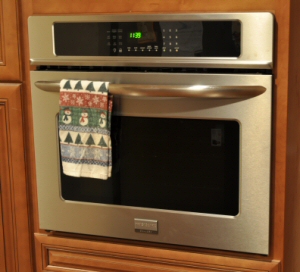
While traditional oven/stove combinations plug in to either a 3- or 4-prong 240-volt socket, wall ovens and cooktops must be direct wired using appropriate junction boxes, usually installed in the cabinet above or below the wall oven, and/or in the cabinet beneath the cooktop.
One common question is whether a separate cooktop and wall oven can be installed on the same circuit. The answer, according to the 2008 National Electric Code, is YES, provided certain conditions are met in the installation.
In general, the rule in section 220.55 of the NEC says that up to two wall ovens and a cook top can be considered a single appliance, so long as they are installed in the same room and meet other relatively simple conditions. This means they can be installed on the same circuit, and it also provides some benefit when calculating the load limit for the circuit.
Demand Factors for Wall Ovens and Cooktops

The same section of the code has a table (also numbered 220.55) that shows allowable demand factors and load limits for a given numbers of appliances and total appliance wattage, which allows you to install higher gauge wire and lower over-current protection than the nominal combined wattage would otherwise dictate.
For example, a cooktop and a wall oven might have a nominal combined draw of 12,000 watts (12 kW) if all the elements were on simultaneously; however, the code allows these units to be installed with assuming an 8,000 watts (8kW) of maximum draw. This is because it isn’t really reasonable to expect that all elements of a cook top and wall oven would be running simultaneously. Even when all of the elements are turned on together, they don’t all draw electricity at the same time. Cook tops and wall ovens cycle the elements as dictated by an internal thermostat. When an element reaches the desired temperature, it shuts off.
Follow the NEC, But Don’t Pay For It!
As a result, there are variety of situations and considerations that we can’t cover in this post. If you’re considering doing this job on your own, there’s no need to purchase a copy of the NEC, which will easily cost you $60 at the link above or from Amazon or another bookseller. You can find one in the reference section of your local library and make photocopies of the code section 220 that you’ll need for this installation.
Remember, you should always follow ALL local codes when performing electrical work. Your jurisdiction may require you to be a licensed electrician to do any electrical work, even in your own home. Your local jurisdiction may also have additional requirements (above and beyond the code) for what electric in your area requires. For example, some local codes may not allow an oven and cooktop to be installed on the same circuit, even though the NEC 2008 allows it. You should contact your local regulator and ask what the specific rules are in your area.
The Cost of Licensed Professionals
Of course, it’s always good to contact a licensed professional before tackling this job. We expect that an electrician would want approximately $400-$1000 to run a new circuit for a cook top or wall oven in a home, depending on what accesses are available and how far the cook top is from the main electric panel. Expect to pay a little more if the electrician has to tear out and repair drywall to do the installation.







willHow would this be mechanically wired using the 50 amp single circuit . What I’m trying to say is when I removed the regular cookstove combination. How do I split this one sheathed conductor set to split off for two devices will? Do I use the same size wire for both devices once it’s split? Is and electrical large involved in any way or do I just to you back for two outlets one for the in wall oven and one for the electric glass cooktop?thank yyou
willHow would this be mechanically wired using the 50 amp single circuit . What I’m trying to say is when I removed the regular cookstove combination. How do I split this one sheathed conductor set to split off for two devices will? Do I use the same size wire for both devices once it’s split? Is and electrical large involved in any way or do I just to you back for two outlets one for the in wall oven and one for the electric glass cooktop?thank yyou
Run a new cable from the breaker to be safe
Calculate the total wattage of the oven and cook top, if its a microwave combo factor that wattage in also.
Hi,
Thank you for sharing all those infos. I would like to know if this also applies to Canadian Building (electircal) standards.
Thank you in advance for taking the time to answer.
Warmest regards.
Robert G.
Alfred, ON.
HI
So i am in a similar situation. I have an electric stove with a 220 outlet. I will be removing the stove and installing 220v ccoktop(4elements) and a wall oven microwave combo. my question is can i use the original 220v outlet that was used for the original stove , split it to go to the new cook top and wall microwave combo? or do i have to run another wire two the breaker box with a 50amp braker for the one of the new appliances?
thanks
I am wanting to do the exact same thing. Samsung wall oven under an induction cooktop, 220 wire from the old range going to a 50amp breaker. Can I wire these all together with wire nuts? Black to black to black, red to red to red, white from oven (4 wire) into all the grounds (cooktop is only 3 wire). Doable?